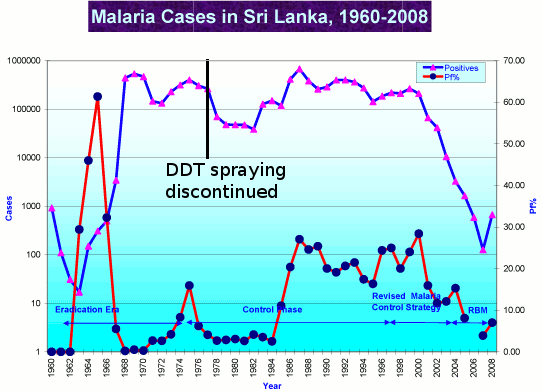I’ll have to beg forgiveness from Tim Lambert, but in the interest of accuracy and good history, I have captured below the post Tim Lambert had on the old Deltoid blog (at the Seed Science Blogs site), dealing with Indur Goklany’s errors on DDT.
A bit of other history: Anthony Watts despises my posts (me, too, probably) and I am banned from his site for various sins including calling him out for suggesting Rachel Carson and President John F. Kennedy had more than an occasional handshake personal relationship (a bizarre charge Christopher Monckton repeats and exaggerates on in slightly different ways). Watts and I disagree on what we should regard as facts; I take the old collegiate debate and Scout Law positions, he sides with the Heartland Institute parody/comedy/hoax troupe.
Watts was having none of my corrections. Tim Lambert, who has researched this particular area of pro-DDT hoaxing more than anyone else, was kind enough to respond.
This is borrowed from the Internet Archive’s Wayback Machine, until, and then maybe a supplement to, the reappearance of Deltoid’s archives at the new site. As of April 10, 2018, I have not checked the links. If links don’t work, please tell me in comments, and I’ll work to get a new link to the old information where possible.
You should also know that Sri Lanka today is certified to be malaria-free, without DDT.
Below, Tim Lambert’s post on Indur Goklany’s errors about DDT history:
Ed Darrell points to a WUWT post by Indur Goklany which promotes the use of DDT to fight malaria instead of more effective measures. As with most of the DDT promoters, Goklany carefully avoids mentioning the way mosquitoes evolve resistance to insecticides. For example, here’s what he has on Sri Lanka:
For instance, malaria incidences in Sri Lanka (Ceylon) dropped from 2.8 million in the 1940s to less than 20 in 1963 (WHO 1999a, Whelan 1992). DDT spraying was stopped in 1964, and by 1969 the number of cases had grown to 2.5 million.
Now compare this with what really happened in Sri Lanka:
With widespread resistance of A. culicifacies to DDT, malathion spraying was introduced in 1975 in areas of P.falciparum transmission affording protection to nearly one million people. Towards the end of 1976 DDT spraying was completely discontinued and during 1977 exclusively malathion was used as an adulticide.

Note that the scale for malaria cases is logarithmic, so there was a factor of ten reduction in the number of cases in a few years after DDT spraying was discontinued.
The misinformation about DDT and malaria that Goklany spreads is harmful and could kill people. DDT still has a place in the fight against malaria (because of insecticide resistance we need as many different insecticides as possible), but there are more effective means available, and by trying to undercut the use of the best methods for fighting malaria, Goklany will be responsible for people dying from malaria.
[End, quote from Tim Lambert’s old Deltoid blog]
Now, is it possible that the comments will copy as well as the blog post? There are some good ones in there.
Here’s a try at copying the comments, below the fold.








Comments [from Deltoid’s original post]
New comments have been temporarily disabled. Please check back soon.
[New comments disabled at Deltoid, not at Millard Fillmore’s Bathtub! Comments open; I wish somebody would comment.]